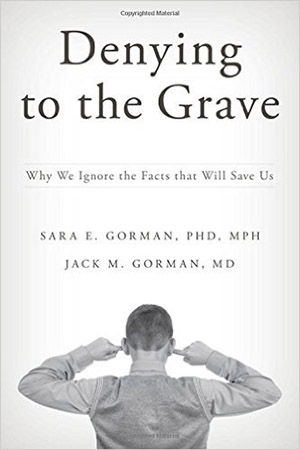[alert variation=”alert-info”]Publisher: Oxford University Press
Formats: Hardcover, eBook, Kindle
Purchase: Powell’s | Amazon | IndieBound | iBooks[/alert]
How timely of a publication! Gorman and Gorman focus on the why behind eight harmful health-related behaviors, ranging from vaccine and antibiotics, to electroconvulsive therapy, but employ a wide variety of examples to illustrate their points. The book includes discussion statistics evidence appraisal, but not in an overwhelming or triggering bio stats flashback way. But never fear, this is not a book that is just full of discussion and no action items. The Gorman-Gorman Method for communicating with people who do not believe the science is presented. It is a series of seven Guiding Principles and six Solutions, a few of which are shared below. “We just want to help people better tease out when their natural psychological tendencies are protecting them and when they are actually harming their health” (p. 243).
Granted, my reading of this book is a form of confirmation bias, nonetheless the authors present a tangible and realistic description of why we believe what we believe even if there is a dearth of evidence to support our view. One of their case examples, I was skeptical about at first glance but used this book to guide myself in rethinking my position. More on Confirmation Bias – I learned two new somethings in this chapter. First, confirmation bias was the basis for cognitive behavioral therapy design of Aaron T. Beck, by breaking the cycle of focusing on depressive thoughts as the only reality. Second, there are also neuroscience studies demonstrating that just like a sweet treat, a drug or other addictive activity, confirming our beliefs with more ‘evidence’ releases dopamine. So, just like giving up an addictive habit, it’s hard to change your beliefs and the path of least resistance and feedback reward is to confirm your position. This is where emotional intelligence can enter, but is not a focus of this book. “Solution #1: Science must deal with increased access to various types of information via the Internet.”
The Chapter on Charismatic Leaders and their influence in public beliefs is powerful and everyone reading should be able to think of examples that have influenced for good and set people down more harmful paths. “Guiding Principle #5 – People respond more to emotion than statistics, but charismatic leaders use emotion and scientists use statistics.” In a similar vein, the dissection of Conspiracy Theories complete with true and false examples was really illuminating, capturing our human nature to create connections and patterns, which has suited us well for thousands of years but might be starting to hinder more than help. “Solution #2: Members of the media need to be better trained to understand what a valid scientific debate is and what is not.”
Gorman and Gorman are fair in the recognition that believing myths or misinformation is not a reflection of intelligence and provide examples to the like (Guiding Principle #1). Their goal is also to not necessarily to persuade beliefs but rather present compelling stories and reasoning. This can be used for your own beliefs or as tactics when dealing with others holding harmful beliefs. Developing motivational interview skills in healthcare professionals is one of their key strategies.
My favorite quote comes at the end, where the authors conclude that a key component to public health and humanity is empathy: “In the end, we don’t want people to scramble for a story when should be paying attention to statistics. But at the same time, we wouldn’t want a society full of people who see only percentages and probabilities in place of showing empathy for the individuals around them” (p. 243).
Now more than ever we need the critical mass to understand the risks that are play inside their own minds and pause, reflect, research, and be brave enough to look at the other side. I highly recommend this book for medical professionals, public health professionals, decision and policy makers, and everyone else who can still peak past the wool they pulled over their own eyes. It should be appearing on syllabus, book clubs and nightstands everywhere. “Solution #6: We all must examine our tendency to think uncritically and to place emotion over reason.”
[signoff predefined=”Social Media Reminder” icon=”twitter”][/signoff]

